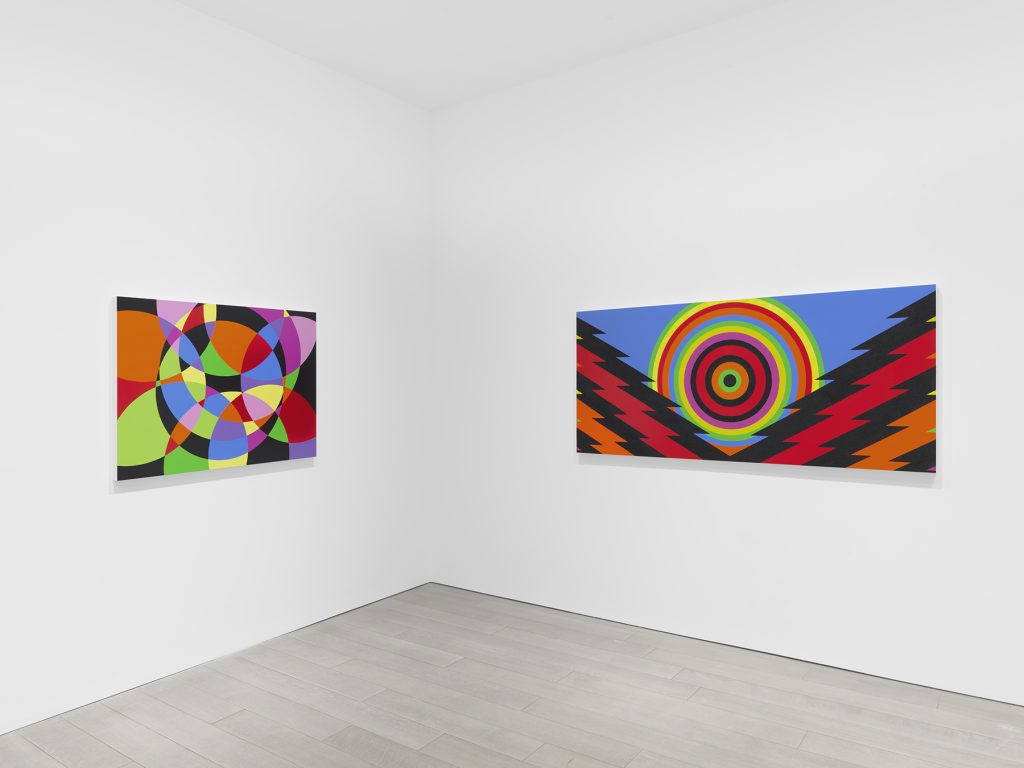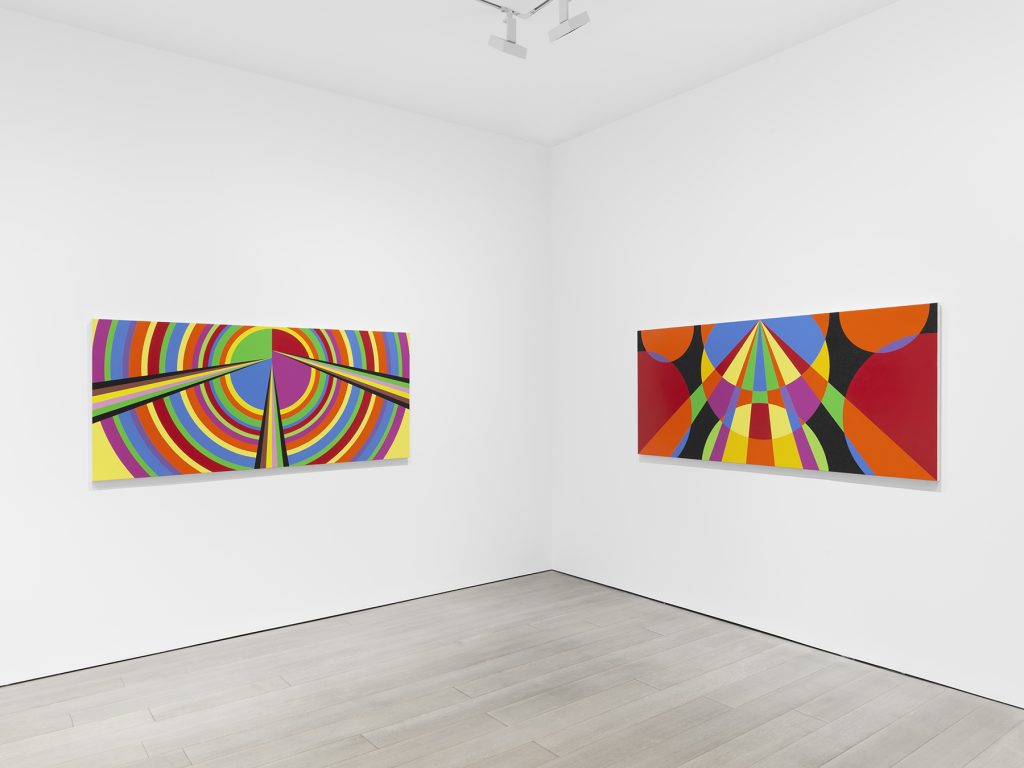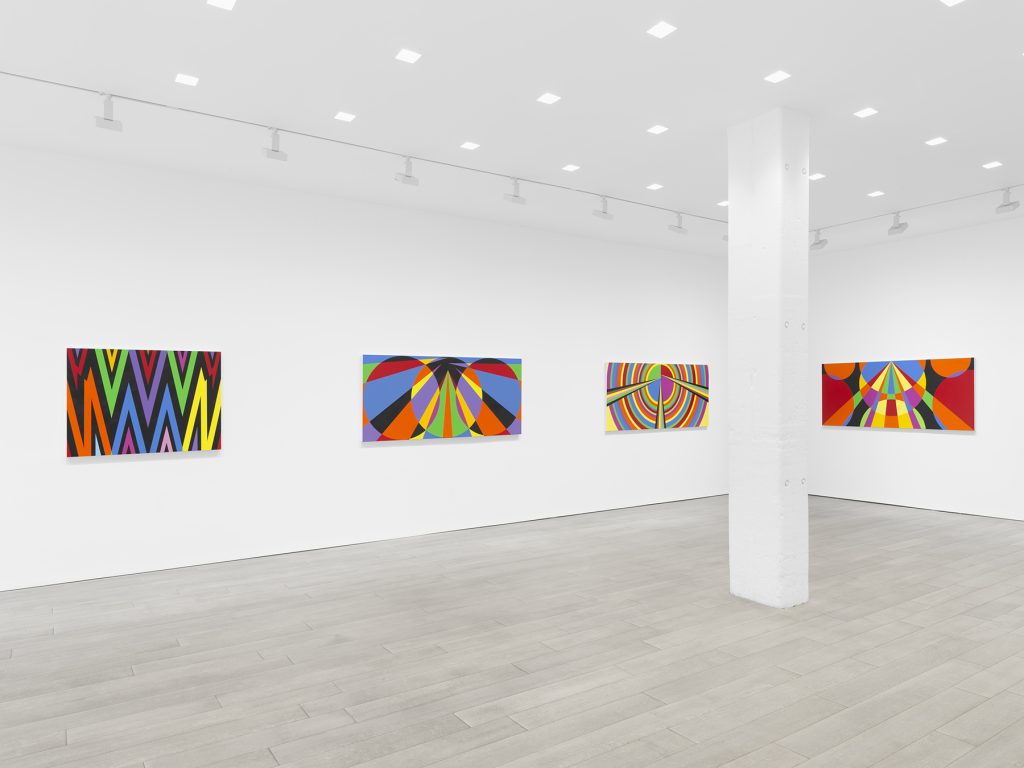The colors in artist Rico Gatson’s new exhibition “Above and Below” at Miles McEnery Gallery in New York City are bright — intensely and refreshingly so.
Rico Gatson’s Relentlessly Joyful Paintings
That’s the first element that commands attention when standing before these paintings, which are comprised of acrylic paint on wood, with some also including glitter.
This series of works from Gatson is abstract, but only logistically speaking (as opposed to something strictly representational).
Gatson’s vibrant and explosive assemblages of often, though not exclusively, rounded forms speak a specific, palpable language: one of relentless, even rebellious joy, and that’s easy to pick up on when standing before one of these works. It’s an exuberance of life that insists upon itself. Gatson’s forms are intricate and nuanced, acknowledging and incorporating a hierarchy of sorts to conceptual and physical space — and by extension, acknowledging the existence of tension. But it’s not in view! Instead, whatever the specifics, these paintings burst with flowing color.
They’re so persistently bright, both in terms of the shimmering fireworks of color combinations and the growing constructions of form, that you could imagine the paintings themselves beckoning you inwards.
A particularly standout group from these paintings includes “Untitled (Circle Theory I)” (2024), which is constructed of overlapping circles in which Gatson filled each individual area formed by the intersecting lines with a burst of wide-ranging color, distinguishing each area from its neighbors — though the overlapping circles providing the basis for the visual construction remain evident.
Gatson’s compositions have a resounding internal strength, as he utilized sharply defined, individual forms in putting his paintings together. And in each area of color, the paint tends to be applied to make individual brushstrokes not easily evident, so the visual impact — both in isolation and in the totality of each individual painting — is forceful.

Gatson’s Paintings Sing in Unison
And while all of this is, logistically speaking, a lot, none of Gatson’s paintings came across as overwhelming. Instead, the effect is more like, in each piece, a symphony of freshly unified color and form. Gatson’s paintings in this exhibition are largely constructed of series of smaller forms building the overall image, and the hard-edged abstraction in his method allows each form to neatly fall away and let the next one arise as everything unites.
He uses that method of applying color to, essentially, make space for more. The nature of his intense, colorful forms is more subsumed by what comes next on the surface of each painting than a harsh, aesthetic confrontation with viewers. And though the energy is persistent, the precise nature of Gatson’s forms gives this series of paintings a reassuring feeling of control, or at least security. The smaller forms on each surface are sized so the rhythms of their combining are exuberant but steady.
Across this exhibition, the visual motif of a bullseye reappears, formed by expanding, concentric circles of again wide-ranging color — which is a relatively stable, visual construction, even if the curvatures mean there’s a distinct, forward push. In keeping his paintings distinctly orderly, Gatson allows the inherent, refreshing impacts of his color and form choices to radiate outwards that much more directly. And if there’s one thing these paintings are, it’s radiant.
An essay by writer Erica Cardwell included in this exhibition’s catalog notes Gatson’s influences in music, and that connection seems evident.
Whatever the precise dynamics of each piece — whether more smoothly outward moving or a gathering of angular forms — Gatson’s artwork pushes and retracts like a carefully cultivated piece of music. I have had the opportunity to interview some musicians who work heavily with improvisation, and it reminds me of a frequent ideal there: a set-up where everything shines but doesn’t overpower what comes next. And that’s how Gatson’s colorfully engaging paintings are presenting themselves.

Healing through Art
Gatson’s work, in general, draws from experiences of Black individuals and communities, and Caldwell’s essay also discusses Gatson’s interest behind this latest series of paintings in leaning into “healing,” which is visually evident. Gatson’s paintings uplift with strength, hearkening towards the cosmic, otherworldly ambitions of some who’ve looked for liberation — while offering such a journey in the now.
Gatson’s usage in these paintings of a rich, reverberating, dark red was a particular standout. I think in just about any context, red brings an intensity to the fore, and here, that translates as emotional need, elevated. It’s an urgent, palpitating push for something greater — subsumed, essentially, into the visual accomplishment of that “greater” thing, an opportunity for that “healing.”
Everything in Gatson’s paintings tends to move fluidly, throwing open the visual gates to an elevation that’s legitimately within reach. Though wide-ranging in color and excitingly impactful in overall energy, each painting and the exhibition as a whole are unified in presenting this to viewers: a psychological world of wonder.
“Rico Gatson: Above and Below” will remain on view at Miles McEnery Gallery in New York through October 26.
Featured image: New York, NY: Miles McEnery Gallery, ‘Rico Gatson: Above and Below,’ 5 September – 26 October 2024. Image: Christopher Burke Studio. Courtesy of the artist and Miles McEnery Gallery, New York, NY
You may also like
-
Diana Kurz at Lincoln Glenn in New York: A Review of a Shining Art Exhibition
-
Dustin Hodges at 15 Orient in New York City: An Ensnaring Exhibition at an Exciting Gallery
-
Maren Hassinger at Susan Inglett Gallery in New York: Reviewing an Uplifting Art Exhibition
-
Enzo Shalom at Bortolami in New York City: Reviewing an Entrancing Exhibition of Paintings
-
“Ben Werther: Townworld” at Amanita in New York City: Reviewing a Richly Memorable Art Exhibition
